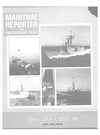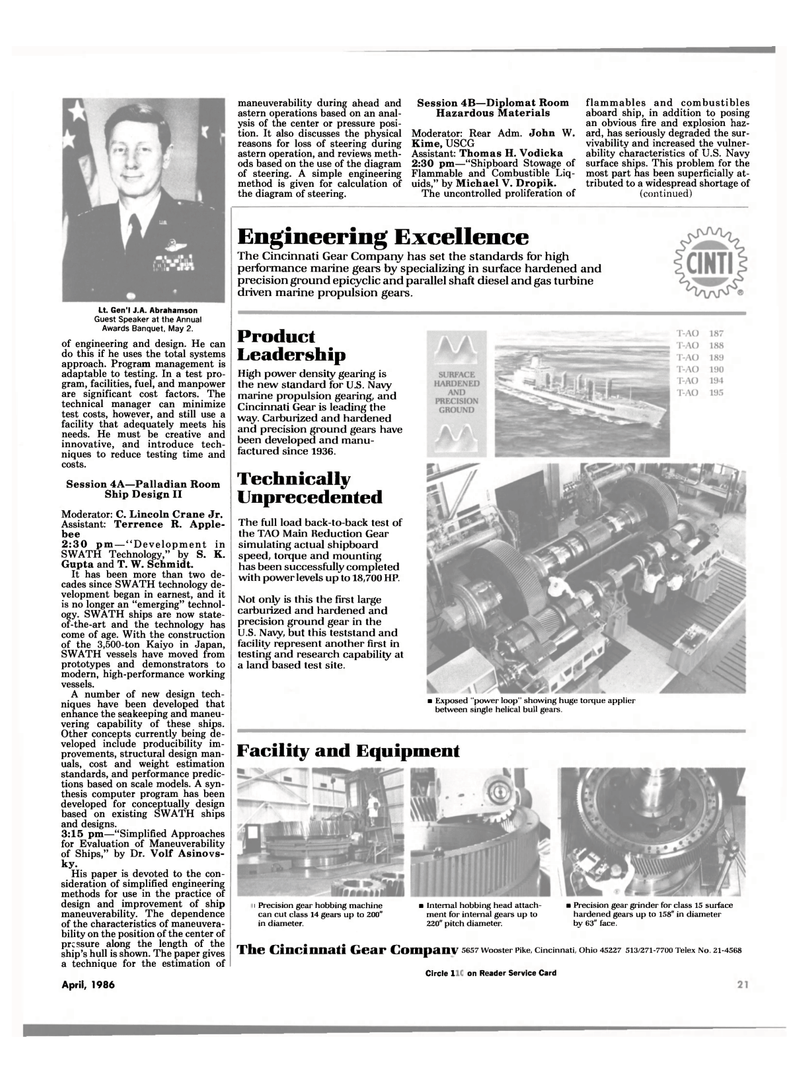
Page 17: of Maritime Reporter Magazine (April 1986)
Read this page in Pdf, Flash or Html5 edition of April 1986 Maritime Reporter Magazine
Lt. Gen'l J.A. Abrahamson
Guest Speaker at the Annual
Awards Banquet, May 2. of engineering and design. He can do this if he uses the total systems approach. Program management is adaptable to testing. In a test pro- gram, facilities, fuel, and manpower are significant cost factors. The technical manager can minimize test costs, however, and still use a facility that adequately meets his needs. He must be creative and innovative, and introduce tech- niques to reduce testing time and costs.
Session 4A—Palladian Room
Ship Design II
Moderator: C. Lincoln Crane Jr.
Assistant: Terrence R. Apple- bee 2:30 pm—"Development in
SWATH Technology," by S. K.
Gupta and T. W. Schmidt.
It has been more than two de- cades since SWATH technology de- velopment began in earnest, and it is no longer an "emerging" technol- ogy. SWATH ships are now state- of-the-art and the technology has come of age. With the construction of the 3,500-ton Kaiyo in Japan,
SWATH vessels have moved from prototypes and demonstrators to modern, high-performance working vessels.
A number of new design tech- niques have been developed that enhance the seakeeping and maneu- vering capability of these ships.
Other concepts currently being de- veloped include producibility im- provements, structural design man- uals, cost and weight estimation standards, and performance predic- tions based on scale models. A syn- thesis computer program has been developed for conceptually design based on existing SWATH ships and designs. 3:15 pm—"Simplified Approaches for Evaluation of Maneuverability of Ships," by Dr. Volf Asinovs- ky.
His paper is devoted to the con- sideration of simplified engineering methods for use in the practice of design and improvement of ship maneuverability. The dependence of the characteristics of maneuvera- bility on the position of the center of pressure along the length of the ship's hull is shown. The paper gives a technique for the estimation of
April, 1986 19 maneuverability during ahead and astern operations based on an anal- ysis of the center or pressure posi- tion. It also discusses the physical reasons for loss of steering during astern operation, and reviews meth- ods based on the use of the diagram of steering. A simple engineering method is given for calculation of the diagram of steering.
Session 4B—Diplomat Room
Hazardous Materials
Moderator: Rear Adm. John W.
Kime, USCG
Assistant: Thomas H. Vodicka 2:30 pm—"Shipboard Stowage of
Flammable and Combustible Liq- uids," by Michael V. Dropik.
The uncontrolled proliferation of flammables and combustibles aboard ship, in addition to posing an obvious fire and explosion haz- ard, has seriously degraded the sur- vivability and increased the vulner- ability characteristics of U.S. Navy surface ships. This problem for the most part has been superficially at- tributed to a widespread shortage of (continued)
Engineering Excellence
The Cincinnati Gear Company has set the standards for high performance marine gears by specializing in surface hardened and precision ground epicyclic and parallel shaft diesel and gas turbine driven marine propulsion gears.
Product
Leadership
High power density gearing is the new standard for U.S. Navy marine propulsion gearing, and
Cincinnati Gear is leading the way. Carburized and hardened and precision ground gears have been developed and manu- factured since 1936.
Technically
Unprecedented
The full load back-to-back test of the TAO Main Reduction Gear simulating actual shipboard speed, torque and mounting has been successfully completed with power levels up to 18,700 HP.
Not only is this the first large carburized and hardened and precision ground gear in the
U.S. Navy, but this teststand and facility represent another first in testing and research capability at a land based test site. • Exposed "power loop" showing huge torque applier between single helical bull gears.
Facility and Equipment i Precision gear hobbing machine • Internal hobbing head attach- • Precision gear grinder for class 15 surface can cut class 14 geais up to 200" ment for internal gears up to hardened gears up to 158" in diameter in diameter. 220" pitch diameter. by 63" face.
The Cincinnati Gear Companv5657WoosterPike'cincinnati'°hio 45227 513/271-7700 Teiex no. 21-4568
Circle 201 on Reader Service Card

 16
16

 18
18
